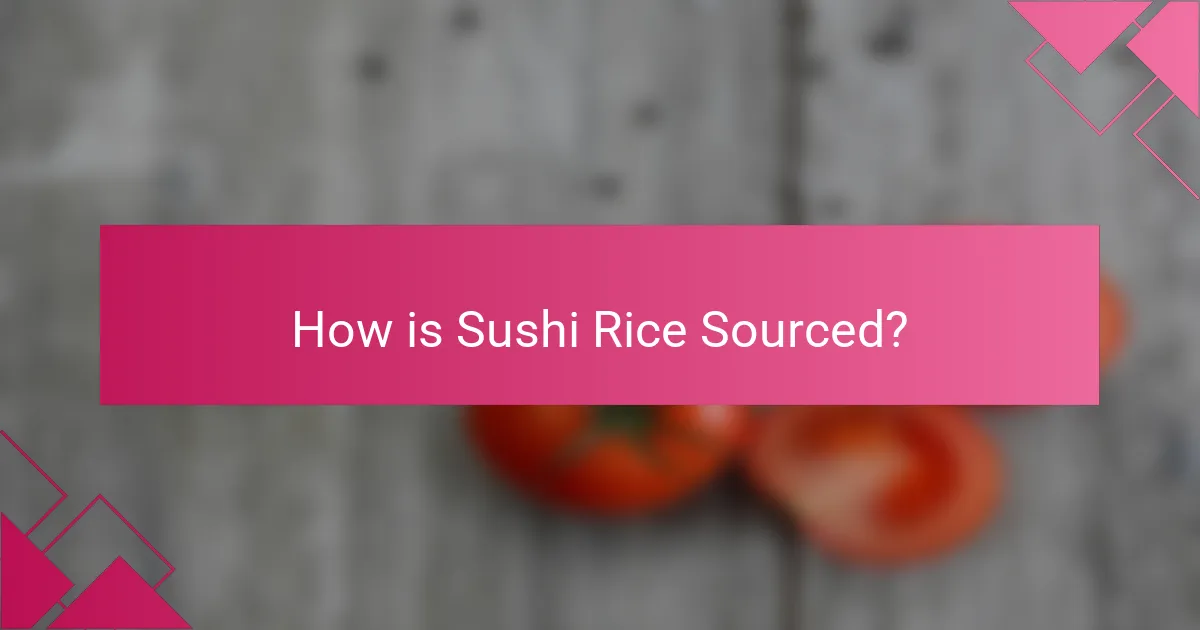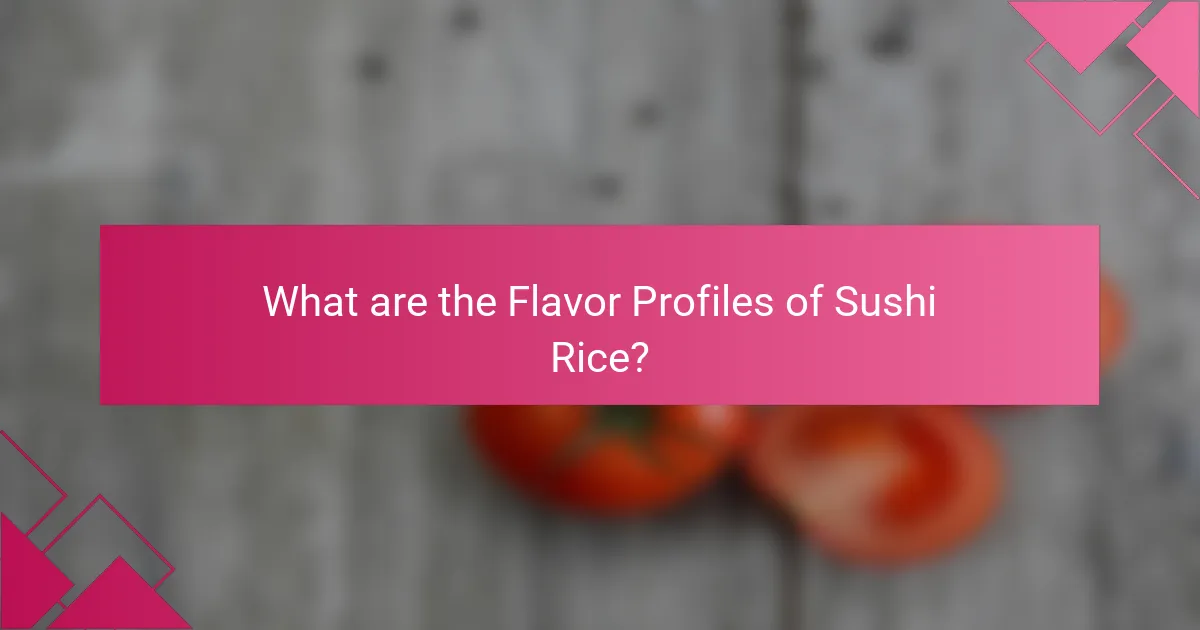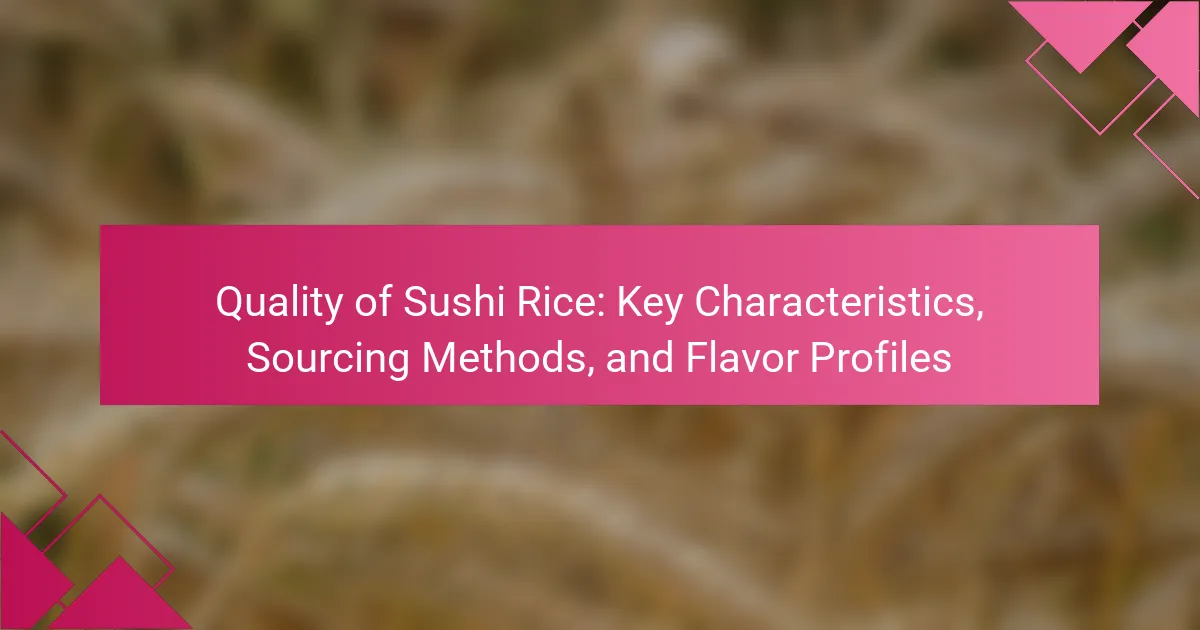
What are the Key Characteristics of Quality Sushi Rice?
Quality sushi rice is characterized by its short grain, sticky texture, and balanced flavor. Short-grain rice, such as Japonica, is ideal for sushi due to its ability to hold together. The stickiness of the rice is crucial for forming sushi rolls and nigiri. A balanced flavor profile, slightly sweet and mildly tangy, is achieved through seasoning with rice vinegar, sugar, and salt. The rice should be cooked to a firm yet tender consistency, ensuring it is neither mushy nor hard. Freshness is vital; high-quality sushi rice is typically harvested annually. The appearance of the rice should be glossy and white, indicating proper polishing and milling. Quality sushi rice enhances the overall sushi experience, making it an essential component of Japanese cuisine.
How does the texture of sushi rice influence its quality?
The texture of sushi rice significantly influences its quality. A well-cooked sushi rice should be sticky yet firm, allowing it to hold its shape. This texture is crucial for forming sushi rolls and nigiri. The stickiness comes from the amylopectin content in short-grain rice, which contributes to the desired consistency. If the rice is too dry or too mushy, it can affect the overall taste and presentation of sushi. Properly textured rice enhances the balance of flavors with the fish and other ingredients. Studies indicate that the ideal sushi rice texture improves the overall dining experience.
What are the ideal grain types for sushi rice?
The ideal grain types for sushi rice are short-grain and medium-grain rice. These types have a higher starch content, which helps achieve the desired sticky texture. The most commonly used variety is Japonica rice, known for its round shape and ability to hold together. This grain type is essential for forming sushi rolls and nigiri. Other suitable options include Koshihikari and Calrose rice. Koshihikari is prized for its sweetness and aroma. Calrose rice is often used for its availability and adaptability. These grain types ensure the proper consistency and flavor for sushi preparation.
How does moisture content affect sushi rice quality?
Moisture content significantly affects sushi rice quality. Optimal moisture content ensures proper texture and stickiness. Sushi rice should have a moisture level around 14-16%. This range allows the rice to hold together without being overly wet or dry. Insufficient moisture results in dry, crumbly rice. Excess moisture can lead to mushy, unappetizing sushi. The right moisture balance enhances flavor absorption during seasoning. Studies indicate that moisture levels directly correlate with the rice’s ability to form cohesive sushi rolls.
What role does stickiness play in sushi rice quality?
Stickiness is crucial for sushi rice quality. It affects the texture and cohesion of the rice. Sushi rice needs to hold together when formed into rolls or nigiri. The stickiness comes from the starch content in the rice. Short-grain rice varieties, like Japonica, have higher amylopectin levels. Amylopectin contributes to the desired sticky texture. Studies show that proper cooking enhances this stickiness. Well-cooked sushi rice maintains its shape and is easier to handle. This quality is essential for both presentation and eating experience.
How is stickiness measured in sushi rice?
Stickiness in sushi rice is measured by its amylose content. Sushi rice typically has a low amylose content, around 15-20%. This low level contributes to the rice’s ability to clump together when cooked. The measurement of stickiness can be assessed using a texture analyzer. This device measures the force required to separate the rice grains. Additionally, sensory evaluations can be conducted by tasting. Trained panels assess the texture and mouthfeel of the rice. Stickiness is crucial for sushi preparation, ensuring that the rice holds its shape. High stickiness enhances the overall sushi experience.
Why is stickiness important for sushi preparation?
Stickiness is crucial for sushi preparation because it helps the rice hold together. Properly cooked sushi rice has a specific starch composition that creates this stickiness. The primary starches, amylopectin and amylose, play a significant role. High amylopectin levels increase stickiness, allowing the rice to maintain its shape when formed into sushi. This characteristic ensures that sushi can be easily picked up with chopsticks and keeps the ingredients intact. Additionally, the right texture enhances the overall eating experience, making it pleasing and cohesive.
What are the visual indicators of high-quality sushi rice?
High-quality sushi rice appears glossy and slightly sticky. The grains should be plump and uniform in size. A good sushi rice has a pearly white color, indicating proper polishing. There should be minimal broken grains present, as this affects texture. The rice should also be free from discoloration or foreign materials. When cooked, high-quality sushi rice maintains a good shape and does not turn mushy. These visual indicators are essential for achieving the desired texture and flavor in sushi.
How can color and shine indicate sushi rice quality?
The color and shine of sushi rice can indicate its quality. High-quality sushi rice typically has a glossy appearance and a pearly white color. This shine results from proper polishing, which removes the outer bran layers while preserving the inner starch. A dull or off-white color suggests poor polishing or aging, affecting texture and flavor. Additionally, premium sushi rice often has a consistent color throughout. Variations may indicate uneven cooking or inferior grains. These visual characteristics are essential for chefs when selecting rice for sushi preparation.
What are the signs of overcooked or undercooked sushi rice?
Overcooked sushi rice appears mushy and sticky, lacking individual grain separation. It may also have a gummy texture, making it difficult to handle. Undercooked sushi rice remains hard and crunchy, with a firm center. It often lacks the necessary moisture and flavor absorption. Proper sushi rice should be slightly firm yet tender, with grains that hold their shape. These characteristics ensure optimal taste and texture for sushi preparation.

How is Sushi Rice Sourced?
Sushi rice is sourced primarily from specific regions known for high-quality rice cultivation. Japan is the most notable country for sushi rice, particularly varieties like Koshihikari and Sasanishiki. These rice types are cultivated in regions such as Niigata, Akita, and Fukushima. Farmers in these areas utilize traditional methods, including specific planting and harvesting techniques, to enhance the rice’s flavor and texture.
The climate and soil conditions in these regions contribute significantly to the rice’s quality. For instance, the combination of ample sunlight and pure water sources is essential for optimal growth. Additionally, rice is often sourced from certified organic farms to ensure it meets quality standards.
The sourcing process typically involves direct relationships between sushi chefs and rice farmers. This ensures that the rice is fresh and meets the specific requirements for sushi preparation. Quality control measures are also implemented to maintain consistency in taste and texture.
What are the primary sourcing methods for sushi rice?
The primary sourcing methods for sushi rice include direct sourcing from rice farmers, importation from specialized suppliers, and purchasing from local distributors. Direct sourcing involves establishing relationships with rice farmers who grow specific varieties suited for sushi. Importation from specialized suppliers ensures access to high-quality rice from regions known for sushi rice production, such as Japan. Local distributors provide convenience and often a variety of brands, making it easier for restaurants and retailers to obtain sushi rice. These methods ensure that sushi rice meets the quality standards necessary for optimal flavor and texture in sushi preparation.
How do farmers select rice varieties for sushi production?
Farmers select rice varieties for sushi production based on specific characteristics. Key attributes include grain size, texture, and stickiness. Short-grain rice is preferred for sushi due to its higher starch content. This starch contributes to the desired sticky texture when cooked. Farmers also consider climate and soil conditions for optimal growth. Varieties such as Koshihikari are renowned for their flavor and texture. Research indicates that the right variety can enhance sushi quality significantly. Studies show that Koshihikari rice has superior taste and consistency, making it a top choice among sushi chefs.
What impact does geographic location have on sushi rice sourcing?
Geographic location significantly impacts sushi rice sourcing. Different regions produce rice varieties with unique qualities. Japan, particularly the Niigata and Akita prefectures, is renowned for premium sushi rice. The climate, soil, and water quality in these areas contribute to the rice’s texture and flavor. Regions outside Japan, like California, also grow sushi rice, but the taste may differ due to environmental factors. The local agricultural practices and rice cultivation methods further influence the quality. For example, Japanese farmers often use traditional techniques that enhance flavor. Therefore, geographic location plays a crucial role in determining the sourcing and quality of sushi rice.
How do cultivation practices affect sushi rice quality?
Cultivation practices significantly affect sushi rice quality. Factors such as soil health, water management, and pest control directly influence the rice’s texture and flavor. For instance, well-drained, fertile soil enhances nutrient absorption. This leads to higher starch content, which is crucial for the desired stickiness of sushi rice. Additionally, proper water management ensures optimal growth conditions. Waterlogged fields can lead to poor grain quality. Furthermore, organic farming practices can improve taste by reducing chemical residues. Studies show that rice grown in traditional methods often has superior flavor profiles compared to conventionally grown rice. Cultivation practices thus play a vital role in determining the overall quality of sushi rice.
What sustainable farming practices are used in sushi rice production?
Sustainable farming practices in sushi rice production include crop rotation, integrated pest management, and organic fertilization. Crop rotation helps maintain soil health and reduce pest populations. Integrated pest management utilizes natural predators to control pests instead of chemical pesticides. Organic fertilization uses compost and green manure to enhance soil fertility. These practices minimize environmental impact and promote biodiversity. Research indicates that sustainable practices can improve rice yield and quality while reducing carbon emissions.
How does water quality influence rice cultivation?
Water quality significantly influences rice cultivation. High-quality water enhances rice growth, while poor water quality can hinder it. Contaminants in water can lead to reduced crop yields. Salinity in water can adversely affect rice plant development. Optimal pH levels in water promote nutrient absorption in rice plants. Studies show that rice yields can drop by 30% with high salinity levels. Clean water sources also reduce the risk of diseases affecting rice crops. Overall, water quality directly impacts the health and productivity of rice cultivation.
What certifications should consumers look for when purchasing sushi rice?
Consumers should look for certifications such as USDA Organic and Non-GMO Project Verified when purchasing sushi rice. These certifications indicate that the rice is grown without harmful pesticides and genetically modified organisms. Additionally, certifications like Certified Gluten-Free ensure that the product is safe for those with gluten sensitivities. The Japan Agricultural Standards (JAS) certification can also signify high-quality Japanese rice. These certifications provide assurance of quality and safety in sushi rice products.
How do organic certifications affect sushi rice quality?
Organic certifications enhance sushi rice quality by ensuring that rice is grown without synthetic pesticides and fertilizers. This method of cultivation promotes healthier soil and biodiversity. Healthier soil contributes to improved nutrient absorption by the rice plants. As a result, the flavor profile of organic sushi rice tends to be richer and more complex. Additionally, organic practices often involve stricter standards for harvesting and processing. These practices can lead to better texture and consistency in the final product. Studies indicate that organic rice can have higher levels of certain nutrients, which may further enhance its quality. Overall, organic certifications positively influence the overall sensory attributes of sushi rice.
What do quality assurance labels indicate about sushi rice?
Quality assurance labels indicate the standards met by sushi rice. These labels reflect the quality, safety, and authenticity of the rice. They often signify that the rice has been tested for contaminants and adheres to specific grading criteria. For example, labels may indicate the rice’s origin, such as “Koshihikari” from Japan. This assures consumers of its premium quality. Furthermore, quality assurance labels often guarantee that the rice is suitable for sushi preparation. They ensure that the rice has the correct texture and stickiness for optimal sushi making.

What are the Flavor Profiles of Sushi Rice?
Sushi rice has a unique flavor profile characterized by sweetness, slight acidity, and umami. The sweetness comes from the short-grain rice, which has a higher starch content. This starch contributes to the rice’s sticky texture, essential for sushi. The slight acidity is introduced through the addition of rice vinegar, sugar, and salt during preparation. This mixture balances the sweetness and enhances the overall flavor. Umami, a savory taste, is present due to the rice’s natural properties and its pairing with fresh ingredients like fish. Together, these elements create a harmonious taste that complements sushi fillings and toppings.
How does the flavor of sushi rice contribute to sushi dishes?
The flavor of sushi rice is essential to the overall taste of sushi dishes. Sushi rice typically has a subtle sweetness and slight tanginess. These flavors complement the umami of fish and other ingredients. The seasoning, often a mixture of rice vinegar, sugar, and salt, enhances the rice’s natural taste. This seasoning creates a balanced flavor profile that enhances the dish. Additionally, the texture of sushi rice contributes to the experience. Properly cooked sushi rice is sticky and firm, allowing it to hold together well. This texture supports the toppings, ensuring a cohesive bite. The flavor and texture of sushi rice are foundational to the enjoyment of sushi.
What are the key flavor components of high-quality sushi rice?
The key flavor components of high-quality sushi rice include sweetness, acidity, and umami. Sweetness comes from the natural sugars in the rice. Acidity is introduced through the vinegar used in seasoning. Umami is enhanced by the quality of the rice and its cooking method. High-quality sushi rice typically has a slightly sticky texture, which helps hold the flavors together. The balance of these components is essential for achieving the desired taste in sushi. The combination of seasoned rice complements the fish and other ingredients used in sushi.
How do different cooking methods affect the flavor of sushi rice?
Different cooking methods significantly influence the flavor of sushi rice. Steaming enhances the natural sweetness and texture of the rice. Boiling can lead to a softer texture but may dilute flavor. Using a rice cooker allows for consistent cooking, preserving the rice’s integrity. Traditional methods, like using a wooden tub, impart a unique aroma. Each method affects moisture retention, impacting overall taste. For instance, overcooked rice can become mushy, altering flavor perception. Proper rinsing before cooking removes excess starch, enhancing flavor clarity. Ultimately, the choice of cooking method shapes the sushi rice’s final taste profile.
What flavor variations can be achieved with sushi rice?
Sushi rice can achieve various flavor variations through the addition of ingredients. Common flavor enhancers include rice vinegar, sugar, and salt. Each of these ingredients contributes to the overall taste profile. For example, rice vinegar adds acidity and a slight tang. Sugar balances the acidity with sweetness, creating a harmonious flavor. Salt enhances the natural flavors of the rice.
Other variations can include the use of flavored vinegars, such as citrus or herb-infused options. Adding mirin, a sweet rice wine, can also impart a different sweetness and depth. Incorporating kombu, a type of seaweed, during cooking can introduce umami notes. Additionally, using different types of rice, such as brown or black rice, can alter the flavor and texture significantly.
These ingredients and methods demonstrate how versatile sushi rice can be in flavor profiles.
How do seasonings influence the taste of sushi rice?
Seasonings significantly enhance the taste of sushi rice. Common seasonings include rice vinegar, sugar, and salt. Rice vinegar adds acidity, balancing the sweetness and enhancing overall flavor. Sugar contributes a subtle sweetness, making the rice more palatable. Salt intensifies the flavors and rounds out the taste profile. The combination of these seasonings creates a harmonious blend. This balance is essential for authentic sushi preparation. Proper seasoning can elevate sushi rice from bland to flavorful. Research indicates that well-seasoned rice is crucial for optimal sushi quality.
What are the effects of aging sushi rice on its flavor?
Aging sushi rice can enhance its flavor profile. The process allows for the development of deeper, more complex flavors. As sushi rice ages, moisture content decreases, leading to firmer grains. This change in texture can enhance the overall mouthfeel of the sushi. Additionally, aging promotes the breakdown of starches, which can improve sweetness. The flavor can become more rounded and less raw. Studies indicate that aged rice can yield better umami characteristics. Overall, aging sushi rice contributes positively to its flavor and texture.
What tips can enhance the flavor of sushi rice in home cooking?
Rinsing sushi rice before cooking enhances its flavor and texture. This process removes excess starch, preventing the rice from becoming gummy. Use cold water for rinsing until it runs clear. This indicates that most starch has been removed.
Adding rice vinegar, sugar, and salt to the cooked rice creates a traditional sushi flavor profile. A common ratio is 1/4 cup rice vinegar, 2 tablespoons sugar, and 1 teaspoon salt per 2 cups of cooked rice. Mix these ingredients while the rice is still warm for better absorption.
Using high-quality short-grain rice is crucial. Varieties like Japonica are known for their sticky texture and ability to hold flavor. Cooking the rice with a little kombu (dried kelp) can also enhance its umami flavor.
Allowing the rice to rest after cooking helps the flavors meld. Cover it with a damp cloth to keep it warm and moist. Finally, serving the rice at the right temperature, slightly warm rather than hot, improves the overall taste experience.
How can home cooks achieve the best flavor balance in sushi rice?
Home cooks can achieve the best flavor balance in sushi rice by using the right ratio of rice vinegar, sugar, and salt. Typically, a mixture of 1/4 cup rice vinegar, 2 tablespoons sugar, and 1 teaspoon salt per 2 cups of cooked rice works well. The rice vinegar adds acidity, which balances the sweetness of the sugar. Salt enhances overall flavor and brings out the natural taste of the rice. Cooking the rice properly is also essential. Rinse the rice until the water runs clear to remove excess starch. This prevents the rice from becoming gummy. After cooking, allow the rice to cool slightly before mixing in the vinegar mixture. This ensures even distribution of flavors. Properly seasoned sushi rice creates a harmonious base for sushi rolls and nigiri.
What common mistakes should be avoided when preparing sushi rice?
Common mistakes to avoid when preparing sushi rice include not rinsing the rice properly. Rinsing removes excess starch, which prevents the rice from becoming too sticky. Another mistake is using the wrong rice variety. Short-grain sushi rice is ideal due to its higher starch content. Failing to measure water accurately can lead to either undercooked or mushy rice. It’s also important not to skip the soaking step, as it allows the rice to absorb moisture evenly. Overcooking the rice can result in a grainy texture, while undercooking leads to hard rice. Lastly, neglecting to season the rice adequately with vinegar, sugar, and salt can diminish its flavor. Each of these mistakes can significantly affect the quality of sushi rice.
Quality sushi rice is defined by its short grain, sticky texture, and balanced flavor, making it essential for sushi preparation. This article examines key characteristics of high-quality sushi rice, including ideal grain types, moisture content, and stickiness, which all influence its quality. It also explores sourcing methods, emphasizing the importance of geographic location and cultivation practices, as well as the flavor profiles that enhance sushi dishes. Additionally, the article highlights tips for achieving optimal flavor balance and common mistakes to avoid when preparing sushi rice.
